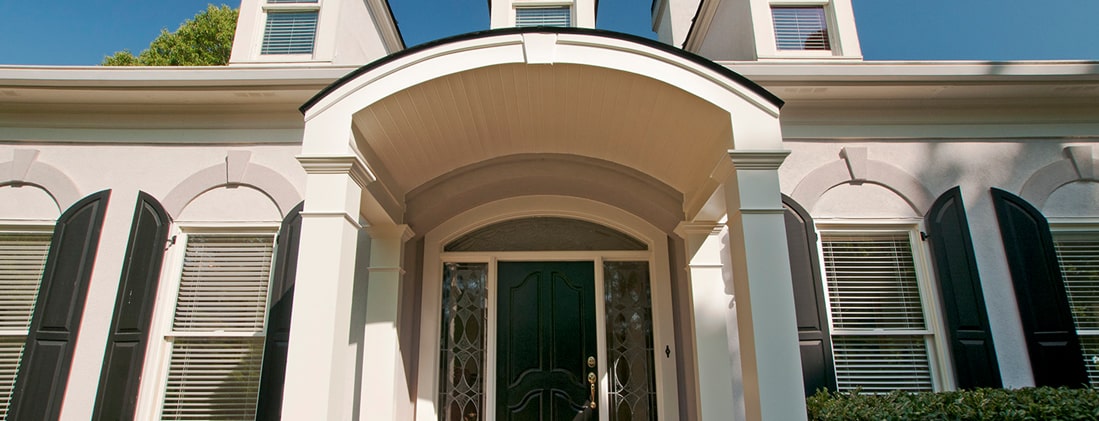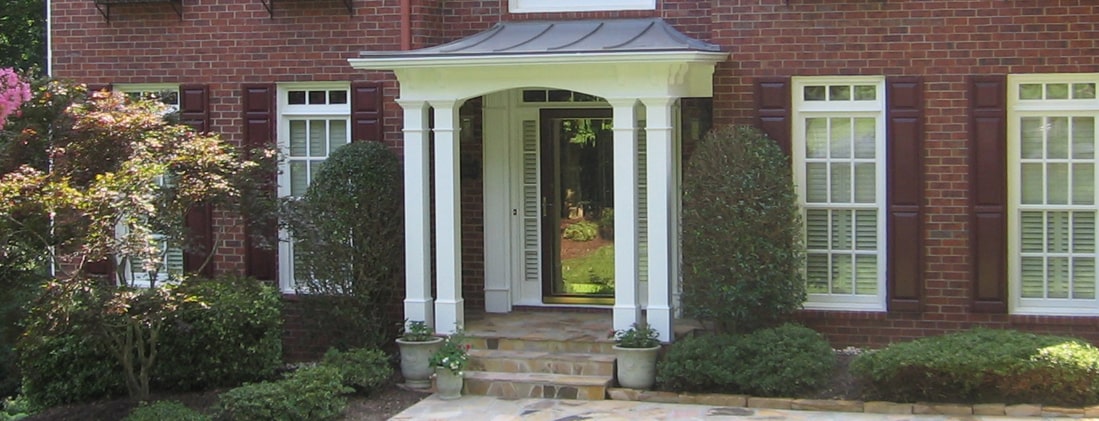
Many people looking to add to the front of their home often ask, “What is a portico?” because many homeowners do not understand exactly what it is. Beyond its historic aspect, this structure is a beautiful architectural feature that can add charm and elegance to residential homes.
What is a Portico?
A portico is a structure consisting of a roof supported by columns, typically leading to the entrance of a building or serving as a covered walkway. This architectural element is commonly found in classical and neoclassical styles of buildings, adding a touch of grandeur and elegance to the overall design. They can vary in size and complexity, ranging from small, simple structures with a few columns to elaborate to multi-columned porticos that span the width of the building facade.
In addition to its aesthetic appeal, a front door portico serves a practical purpose for homeowners. It provides shelter from the elements, offering a welcoming space for guests to pause before entering the home. The columns supporting its roof can be customized to match the architectural style of the house, adding character and visual interest to the overall design.
Whether adorning the entrance of a cozy cottage or a stately manor, porticos create a sense of grandeur and importance, elevating the façade of any home. Its classic and timeless design can enhance the overall look of a residence and make a lasting impression on visitors. Consider adding a portico over the front door to create a sophisticated and inviting entrance that reflects your style and enhances the beauty of your property.
Portico Designs to Complement Your Home’s Façade
- Classical: Inspired by Greek and Roman architecture, classical structures often feature columns with ornate capitals and a pediment at the top. This style exudes elegance and sophistication, making it a timeless choice for traditional homes.
- Colonial: Commonly found in Colonial-style homes, these typically have square columns and a simple pediment. They offer a clean and classic look that complements the symmetrical design of Colonial architecture.
- Craftsman: Reflecting the Arts and Crafts movement, Craftsman-style structures often showcase sturdy square or tapered columns with exposed wooden elements. These porticos have a more rustic and handcrafted feel, adding warmth and charm to a home.
- Contemporary: Modern homes may feature a sleek and minimalist design with clean lines and geometric shapes. Contemporary porticos often prioritize simplicity and functionality, complementing the overall aesthetic of the house.
- Gabled: This has a roof that slopes on two sides, resembling a small gable. This style adds a decorative touch to the entrance of a home and can complement various architectural styles.
- Mediterranean: Drawing inspiration from Mediterranean villas, this style often incorporates arches, stucco finishes, and decorative detailing. Mediterranean porticos exude a relaxed and inviting vibe, perfect for creating a welcoming entrance.
- Farmhouse: Farmhouse-style is characterized by a combination of wood and metal elements, with a focus on practicality and comfort. These porticos often feature a covered porch with simple yet charming details.
Each design has its unique characteristics and can be customized to suit the architectural style and personal preferences of homeowners. Whether you prefer a timeless classical design or a more contemporary look, incorporating any of these styles into your home’s portico can elevate its curb appeal and create a striking entrance that leaves a lasting impression.
Porticos Offer Homeowners Important Advantages
One of the key benefits of having a portico is the visual impact it creates, adding elegance and grandeur to the façade of a home or building. It serves as a focal point and can make a strong first impression on visitors or potential buyers. Additionally, a portico provides shelter from the elements, offering protection from rain, snow, or harsh sunlight, which can be especially useful for welcoming guests or creating an inviting entrance.
In addition to its aesthetic and functional advantages, a portico can also increase the value of a property. Real estate experts often note that homes with well-designed porticos tend to command higher selling prices and attract more interest from prospective buyers.
Furthermore, it can serve as a space for outdoor decoration or seasonal displays, allowing homeowners to showcase their style and enhance the curb appeal of their property. Overall, investing in this structure can be a wise decision for homeowners looking to elevate the look and value of their property.
Factors to Consider when Designing a Residential Portico
- Architectural Style: The design should complement the architectural style of the home. Whether your home is traditional, modern, colonial, or another style, the portico should harmonize with the existing structure and enhance its overall appearance.
- Size and Scale: The size of the portico should be proportional to the size of the home. It should not overwhelm the façade or appear too small about the rest of the house. Consider the dimensions of the entryway and surrounding elements when determining the appropriate size.
- Roof Design: The portico’s roof is a defining element of its design. Choose a roof style that complements the roofline of the house, whether it’s gabled, hipped, flat, or another design. The roof should protect from the elements and help define the space.
- Columns and Supports: The columns or supports play a significant role in its aesthetic appeal. Consider the style, material, and placement of the columns to create a cohesive look with the rest of the home. Columns can be round, square, tapered, or fluted, depending on the desired aesthetic.
- Materials: Select durable and high-quality materials for the construction. Popular choices include wood, stone, brick, and metal. Consider the maintenance requirements, cost, and longevity of the materials when making your selection.
- Lighting: Incorporating lighting into the design can enhance its visual appeal and functionality. Consider adding wall sconces, pendant lights, or recessed lighting to illuminate the entrance and create a welcoming ambiance.
- Landscaping: The landscaping should complement its design and enhance the overall curb appeal of the home. Consider adding planters, flower beds, or other greenery to frame the entrance and soften the transition between the portico and the surrounding landscape.
A Portico is the Addition Your Home Needs
Relying on a professional reputable company like Georgia Front Porch to design the perfect portico brings a wealth of expertise and experience to the table. Professional designers understand the nuances of architecture, structural integrity, and aesthetic appeal, ensuring that your structure is not only visually stunning but also built to last.
With their knowledge of materials, construction techniques, and building codes, GFP’s curb appeal specialists can navigate the design process smoothly and help you avoid costly mistakes that may arise from DIY attempts. By entrusting your design to experts, you can rest assured that the result will exceed your expectations and enhance the beauty and functionality of your home.
When it comes to creating a residential portico that enhances the curb appeal and value of your home, trusting a team of specialists like Georgia Front Porch is key. Their expertise, attention to detail, and commitment to quality craftsmanship set them apart in the industry, ensuring that your structure is designed and built to the highest standards. Contact Georgia Front Porch today to begin the journey towards transforming your home with a beautifully designed and expertly crafted portico that will leave a lasting impression on visitors and passersby alike.
Call Georgia Front Porch today at 770) 781-8234 to schedule a free consultation and let’s start designing the perfect portico for your home!

